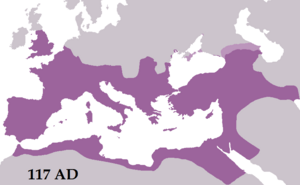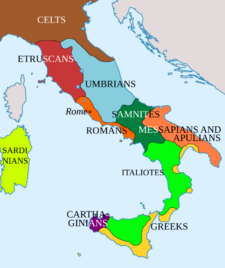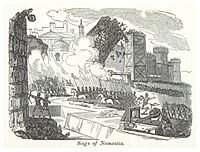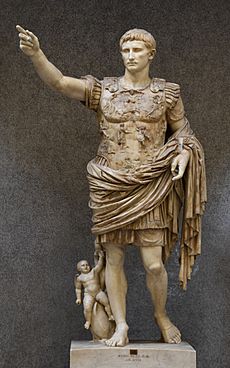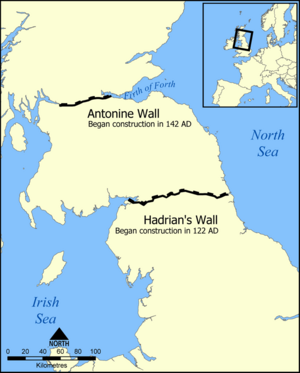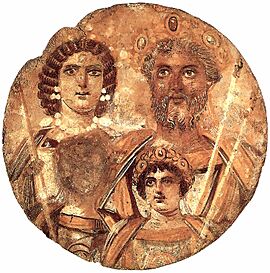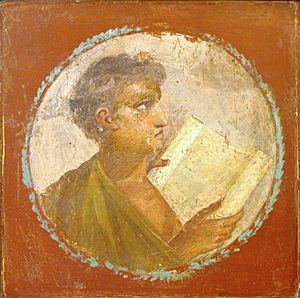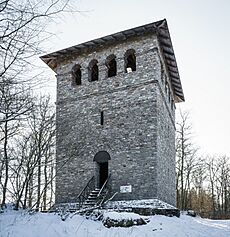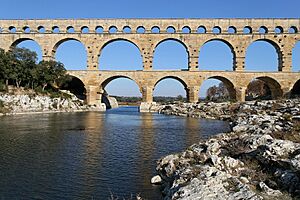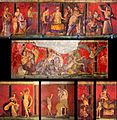Ancient Rome facts for kids
Ancient Rome is the name for a civilization in Italy. It began as a small farming community in the 8th century BC. It became a city and took the name of Roma from its founder Romulus. It grew to become the largest empire in the ancient world. It started as a kingdom, then became a republic, then an empire.
The Roman Empire was so big that there were problems ruling Rome's vast territory that stretched from Britain to the Middle East. In 293 AD, Diocletian split the empire into two parts. A century later, in 395 AD, it was permanently split into the Western Roman Empire and the Eastern Roman Empire. The Western Empire ended because of the Germanic tribe, the Visigoths in 476 AD. In the 5th century AD, the western part of the empire split up into different kingdoms. The eastern Roman Empire stayed together as the Byzantine Empire. The Byzantine Empire was defeated by the Ottoman Empire in 1453.
Rome was founded, according to legend, on 21 April 753 BC and fell in 476 AD, having nearly 1200 years of independence and roughly 700 years of rule as a major power in the ancient world. This makes it one of the longest lasting civilizations in the antiquity.
Contents
History
Early Italy and the founding of Rome
Archaeological evidence of settlement around Rome starts to emerge c. 1000 BC. Large-scale organisation appears only c. 800 BC, with the first graves in the Esquiline Hill's necropolis, along with a clay and timber wall on the bottom of the Palatine Hill dating to the middle of the 8th century BC. Starting from c. 650 BC, the Romans started to drain the valley between the Capitoline and Palatine Hills, where today sits the Roman Forum. By the sixth century BC, the Romans were constructing the Temple of Jupiter Optimus Maximus on the Capitoline and expanding to the Forum Boarium located between the Capitoline and Aventine Hills.

Kingdom

Literary and archaeological evidence is clear on there having been kings in Rome, attested in fragmentary 6th century BC texts. Long after the abolition of the Roman monarchy, a vestigial rex sacrorum was retained to exercise the monarch's former priestly functions. The Romans believed that their monarchy was elective, with seven legendary kings who were largely unrelated by blood.
Evidence of Roman expansion is clear in the sixth century BC; by its end, Rome controlled a territory of some 780 square kilometres (300 square miles) with a population perhaps as high as 35,000. A palace, the Regia, was constructed c. 625 BC; the Romans attributed the creation of their first popular organisations and the Senate to the regal period as well. Rome also started to extend its control over its Latin neighbours. While later Roman stories like the Aeneid asserted that all Latins descended from the titular character Aeneas, a common culture is attested to archaeologically. Attested to reciprocal rights of marriage and citizenship between Latin cities—the Jus Latii—along with shared religious festivals, further indicate a shared culture. By the end of the 6th century, most of this area had become dominated by the Romans.
Republic
By the end of the sixth century, Rome and many of its Italian neighbours entered a period of turbulence. Archaeological evidence implies some degree of large-scale warfare. According to tradition and later writers such as Livy, the Roman Republic was established c. 509 BC, when the last of the seven kings of Rome, Tarquin the Proud, was deposed and a system based on annually elected magistrates and various representative assemblies was established. A constitution set a series of checks and balances, and a separation of powers. The most important magistrates were the two consuls, who together exercised executive authority such as imperium, or military command. The consuls had to work with the Senate, which was initially an advisory council of the ranking nobility, or patricians, but grew in size and power.
Other magistrates of the Republic include tribunes, quaestors, aediles, praetors and censors. The magistracies were originally restricted to patricians, but were later opened to common people, or plebeians. Republican voting assemblies included the comitia centuriata (centuriate assembly), which voted on matters of war and peace and elected men to the most important offices, and the comitia tributa (tribal assembly), which elected less important offices.
In the 4th century BC, Rome had come under attack by the Gauls, who now extended their power in the Italian peninsula beyond the Po Valley and through Etruria. On 16 July 390 BC, a Gallic army under the leadership of tribal chieftain Brennus, defeated the Romans at the Battle of the Allia and marched to Rome. The Gauls looted and burned the city, then laid siege to the Capitoline Hill, where some Romans had barricaded themselves, for seven months. The Gauls then agreed to give the Romans peace in exchange for 1000 pounds of gold. According to later legend, the Roman supervising the weighing noticed that the Gauls were using false scales. The Romans then took up arms and defeated the Gauls. Their victorious general Camillus remarked "With iron, not with gold, Rome buys her freedom."
The Romans gradually subdued the other peoples on the Italian peninsula, including the Etruscans. The last threat to Roman hegemony in Italy came when Tarentum, a major Greek colony, enlisted the aid of Pyrrhus of Epirus in 281 BC, but this effort failed as well. The Romans secured their conquests by founding Roman colonies in strategic areas, thereby establishing stable control over the region.
Punic Wars

In the 3rd century BC Rome faced a new and formidable opponent: Carthage, the other major power in the Western Mediterranean. The First Punic War began in 264 BC, when the city of Messana asked for Carthage's help in their conflicts with Hiero II of Syracuse. After the Carthaginian intercession, Messana asked Rome to expel the Carthaginians. Rome entered this war because Syracuse and Messana were too close to the newly conquered Greek cities of Southern Italy and Carthage was now able to make an offensive through Roman territory; along with this, Rome could extend its domain over Sicily.
Carthage was a maritime power, and the Roman lack of ships and naval experience made the path to the victory a long and difficult one for the Roman Republic. Despite this, after more than 20 years of war, Rome defeated Carthage and a peace treaty was signed. Among the reasons for the Second Punic War was the subsequent war reparations Carthage acquiesced to at the end of the First Punic War. The war began with the audacious invasion of Hispania by Hannibal, who marched through Hispania to the Italian Alps, causing panic among Rome's Italian allies. The best way found to defeat Hannibal's purpose of causing the Italians to abandon Rome was to delay the Carthaginians with a guerrilla war of attrition, a strategy propounded by Quintus Fabius Maximus Verrucosus. Hannibal's invasion lasted over 16 years, ravaging Italy, but ultimately Carthage was defeated in the decisive Battle of Zama in October 202 BC.
More than a half century after these events, Carthage was left humiliated and the Republic's focus was now directed towards the Hellenistic kingdoms of Greece and revolts in Hispania. However, Carthage, having paid the war indemnity, felt that its commitments and submission to Rome had ceased, a vision not shared by the Roman Senate. The Third Punic War began when Rome declared war against Carthage in 149 BC. Carthage resisted well at the first strike but could not withstand the attack of Scipio Aemilianus, who entirely destroyed the city, enslaved all the citizens and gained control of that region, which became the province of Africa. All these wars resulted in Rome's first overseas conquests (Sicily, Hispania and Africa) and the rise of Rome as a significant imperial power.
Late Republic
After defeating the Macedonian and Seleucid Empires in the 2nd century BC, the Romans became the dominant people of the Mediterranean Sea. The conquest of the Hellenistic kingdoms brought the Roman and Greek cultures in closer contact and the Roman elite, once rural, became cosmopolitan. At this time Rome was a consolidated empire—in the military view—and had no major enemies.
Foreign dominance led to internal strife. Senators became rich at the provinces' expense; soldiers, who were mostly small-scale farmers, were away from home longer and could not maintain their land; and the increased reliance on foreign slaves and the growth of latifundia reduced the availability of paid work. Income from war booty, mercantilism in the new provinces, and tax farming created new economic opportunities for the wealthy, forming a new class of merchants, called the equestrians. The lex Claudia forbade members of the Senate from engaging in commerce, so while the equestrians could theoretically join the Senate, they were severely restricted in political power. The Senate squabbled perpetually, repeatedly blocked important land reforms and refused to give the equestrian class a larger say in the government.
Violent gangs of the urban unemployed, controlled by rival Senators, intimidated the electorate through violence. The situation came to a head in the late 2nd century BC under the Gracchi brothers, a pair of tribunes who attempted to pass land reform legislation that would redistribute the major patrician landholdings among the plebeians. Both brothers were killed and the Senate passed reforms reversing the Gracchi brother's actions. This led to the growing divide of the plebeian groups (populares) and equestrian classes (optimates).
Gaius Marius soon become a leader of the Republic, holding the first of his seven consulships (an unprecedented number) in 107 BC by arguing that his former patron Quintus Caecilius Metellus Numidicus was not able to defeat and capture the Numidian king Jugurtha. Marius then started his military reform: in his recruitment to fight Jugurtha, he levied the very poor (an innovation), and many landless men entered the army. Marius was elected for five consecutive consulships from 104 to 100 BC, as Rome needed a military leader to defeat the Cimbri and the Teutones, who were threatening Rome. After Marius's retirement, Rome had a brief peace, during which the Italian socii ("allies" in Latin) requested Roman citizenship and voting rights. The reformist Marcus Livius Drusus supported their legal process but was assassinated, and the socii revolted against the Romans in the Social War. At one point both consuls were killed; Marius was appointed to command the army together with Lucius Julius Caesar and Lucius Cornelius Sulla.
By the end of the Social War, Marius and Sulla were the premier military men in Rome and their partisans were in conflict, both sides jostling for power. In 88 BC, Sulla was elected for his first consulship and his first assignment was to defeat Mithridates VI of Pontus, whose intentions were to conquer the Eastern part of the Roman territories. However, Marius's partisans managed his installation to the military command, defying Sulla and the Senate. To consolidate his own power, Sulla conducted a surprising and illegal action: he marched to Rome with his legions, killing all those who showed support to Marius's cause. In the following year, 87 BC, Marius, who had fled at Sulla's march, returned to Rome while Sulla was campaigning in Greece. He seized power along with the consul Lucius Cornelius Cinna and killed the other consul, Gnaeus Octavius, achieving his seventh consulship. Marius and Cinna revenged their partisans by conducting a massacre.
Marius died in 86 BC, due to age and poor health, just a few months after seizing power. Cinna exercised absolute power until his death in 84 BC. After returning from his Eastern campaigns, Sulla had a free path to reestablish his own power. In 83 BC he made his second march on Rome and began a time of terror: thousands of nobles, knights and senators were executed. Sulla held two dictatorships and one more consulship, which began the crisis and decline of Roman Republic.
Caesar and the First Triumvirate

In the mid-1st century BC, Roman politics were restless. Political divisions in Rome split into one of two groups, populares (who hoped for the support of the people) and optimates (the "best", who wanted to maintain exclusive aristocratic control). Sulla overthrew all populist leaders and his constitutional reforms removed powers (such as those of the tribune of the plebs) that had supported populist approaches. Meanwhile, social and economic stresses continued to build; Rome had become a metropolis with a super-rich aristocracy, debt-ridden aspirants, and a large proletariat often of impoverished farmers. The latter groups supported the Catilinarian conspiracy—a resounding failure since the consul Marcus Tullius Cicero quickly arrested and executed the main leaders.
Gaius Julius Caesar reconciled the two most powerful men in Rome: Marcus Licinius Crassus, who had financed much of his earlier career, and Crassus' rival, Gnaeus Pompeius Magnus (anglicised as Pompey), to whom he married his daughter. He formed them into a new informal alliance including himself, the First Triumvirate ("three men"). Caesar's daughter died in childbirth in 54 BC, and in 53 BC, Crassus invaded Parthia and was killed in the Battle of Carrhae; the Triumvirate disintegrated. Caesar conquered Gaul, obtained immense wealth, respect in Rome and the loyalty of battle-hardened legions. He became a threat to Pompey and was loathed by many optimates. Confident that Caesar could be stopped by legal means, Pompey's party tried to strip Caesar of his legions, a prelude to Caesar's trial, impoverishment, and exile.
To avoid this fate, Caesar crossed the Rubicon River and invaded Rome in 49 BC. The Battle of Pharsalus was a brilliant victory for Caesar and in this and other campaigns, he destroyed all of the optimates leaders: Metellus Scipio, Cato the Younger, and Pompey's son, Gnaeus Pompeius. Pompey was murdered in Egypt in 48 BC. Caesar was now pre-eminent over Rome: in five years he held four consulships, two ordinary dictatorships, and two special dictatorships, one for perpetuity. He was murdered in 44 BC, on the Ides of March by the Liberatores.
Octavian and the Second Triumvirate
Caesar's assassination caused political and social turmoil in Rome; the city was ruled by his friend and colleague, Marcus Antonius. Soon afterward, Octavius, whom Caesar adopted through his will, arrived in Rome. Octavian (historians regard Octavius as Octavian due to the Roman naming conventions) tried to align himself with the Caesarian faction. In 43 BC, along with Antony and Marcus Aemilius Lepidus, Caesar's best friend, he legally established the Second Triumvirate. Upon its formation, 130–300 senators were executed, and their property was confiscated, due to their supposed support for the Liberatores.
In 42 BC, the Senate deified Caesar as Divus Iulius; Octavian thus became Divi filius, the son of the deified. In the same year, Octavian and Antony defeated both Caesar's assassins and the leaders of the Liberatores, Marcus Junius Brutus and Gaius Cassius Longinus, in the Battle of Philippi. The Second Triumvirate was marked by the proscriptions of many senators and equites: after a revolt led by Antony's brother Lucius Antonius, more than 300 senators and equites involved were executed, although Lucius was spared.
The Triumvirate divided the Empire among the triumvirs: Lepidus was given charge of Africa, Antony, the eastern provinces, and Octavian remained in Italia and controlled Hispania and Gaul. The Second Triumvirate expired in 38 BC but was renewed for five more years. However, the relationship between Octavian and Antony had deteriorated, and Lepidus was forced to retire in 36 BC after betraying Octavian in Sicily. By the end of the Triumvirate, Antony was living in Ptolemaic Egypt, ruled by his lover, Cleopatra VII. Antony's affair with Cleopatra was seen as an act of treason, since she was queen of another country. Additionally, Antony adopted a lifestyle considered too extravagant and Hellenistic for a Roman statesman. Following Antony's Donations of Alexandria, which gave to Cleopatra the title of "Queen of Kings", and to Antony's and Cleopatra's children the regal titles to the newly conquered Eastern territories, war between Octavian and Antony broke out. Octavian annihilated Egyptian forces in the Battle of Actium in 31 BC. Antony and Cleopatra committed suicide. Now Egypt was conquered by the Roman Empire.
Empire – the Principate
In 27 BC and at the age of 36, Octavian was the sole Roman leader. In that year, he took the name Augustus. That event is usually taken by historians as the beginning of Roman Empire. Officially, the government was republican, but Augustus assumed absolute powers. His reform of the government brought about a two-century period colloquially referred to by Romans as the Pax Romana.
Julio-Claudian dynasty
The Julio-Claudian dynasty was established by Augustus. The emperors of this dynasty were Augustus, Tiberius, Caligula, Claudius and Nero. The Julio-Claudians started the destruction of republican values, but on the other hand, they boosted Rome's status as the central power in the Mediterranean region. While Caligula and Nero are usually remembered in popular culture as dysfunctional emperors, Augustus and Claudius are remembered as successful in politics and the military. This dynasty instituted imperial tradition in Rome and frustrated any attempt to reestablish a Republic.
Augustus (r. 27 BC – AD 14) gathered almost all the republican powers under his official title, princeps, and diminished the political influence of the senatorial class by boosting the equestrian class. The senators lost their right to rule certain provinces, like Egypt, since the governor of that province was directly nominated by the emperor. The creation of the Praetorian Guard and his reforms in the military, creating a standing army with a fixed size of 28 legions, ensured his total control over the army. Compared with the Second Triumvirate's epoch, Augustus' reign as princeps was very peaceful, which led the people and the nobles of Rome to support Augustus, increasing his strength in political affairs. His generals were responsible for the field command, gaining such commanders as Marcus Vipsanius Agrippa, Nero Claudius Drusus and Germanicus much respect from the populace and the legions. Augustus intended to extend the Roman Empire to the whole known world, and in his reign, Rome conquered Cantabria, Aquitania, Raetia, Dalmatia, Illyricum and Pannonia. Under Augustus' reign, Roman literature grew steadily in what is known as the Golden Age of Latin Literature. Poets like Virgil, Horace, Ovid and Rufus developed a rich literature, and were close friends of Augustus. Along with Maecenas, he sponsored patriotic poems, such as Virgil's epic Aeneid and historiographical works like those of Livy. Augustus continued the changes to the calendar promoted by Caesar, and the month of August is named after him. Augustus brought a peaceful and thriving era to Rome, known as Pax Augusta or Pax Romana. Augustus died in 14 AD, but the empire's glory continued after his era.

The Julio-Claudians continued to rule Rome after Augustus' death and remained in power until the death of Nero in 68 AD. Influenced by his wife, Livia Drusilla, Augustus appointed her son from another marriage, Tiberius, as his heir. The Senate agreed with the succession, and granted to Tiberius the same titles and honours once granted to Augustus: the title of princeps and Pater patriae, and the Civic Crown. However, Tiberius was not an enthusiast for political affairs: after agreement with the Senate, he retired to Capri in 26 AD, and left control of the city of Rome in the hands of the praetorian prefect Sejanus (until 31 AD) and Macro (from 31 to 37 AD).
Tiberius died (or was killed) in 37 AD. The male line of the Julio-Claudians was limited to Tiberius' nephew Claudius, his grandson Tiberius Gemellus and his grand-nephew Caligula. As Gemellus was still a child, Caligula was chosen to rule the empire. He was a popular leader in the first half of his reign, but became a crude and insane tyrant in his years controlling government. The Praetorian Guard murdered Caligula four years after the death of Tiberius, and, with belated support from the senators, proclaimed his uncle Claudius as the new emperor. Claudius was not as authoritarian as Tiberius and Caligula. Claudius conquered Lycia and Thrace; his most important deed was the beginning of the conquest of Britannia. Claudius was poisoned by his wife, Agrippina the Younger in 54 AD. His heir was Nero, son of Agrippina and her former husband, since Claudius' son Britannicus had not reached manhood upon his father's death.
Nero sent his general, Suetonius Paulinus, to invade modern-day Wales, where he encountered stiff resistance. The Celts there were independent, tough, resistant to tax collectors, and fought Paulinus as he battled his way across from east to west. It took him a long time to reach the north west coast, and in 60 AD he finally crossed the Menai Strait to the sacred island of Mona (Anglesey), the last stronghold of the druids. His soldiers attacked the island and massacred the druids: men, women and children, destroyed the shrine and the sacred groves and threw many of the sacred standing stones into the sea. While Paulinus and his troops were massacring druids in Mona, the tribes of modern-day East Anglia staged a revolt led by queen Boadicea of the Iceni. The rebels sacked and burned Camulodunum, Londinium and Verulamium (modern-day Colchester, London and St Albans respectively) before they were crushed by Paulinus. Boadicea, like Cleopatra before her, took her own life to avoid the disgrace of being paraded in triumph in Rome. Nero is widely known as the first persecutor of Christians and for the Great Fire of Rome, rumoured to have been started by the emperor himself. A conspiracy against Nero in 65 AD under Calpurnius Piso failed, but in 68 AD the armies under Julius Vindex in Gaul and Servius Sulpicius Galba in modern-day Spain revolted. Deserted by the Praetorian Guards and condemned to death by the senate, Nero killed himself.
As Roman provinces were being established throughout the Mediterranean, Italy maintained a special status which made it domina provinciarum ("ruler of the provinces"), and – especially in relation to the first centuries of imperial stability – rectrix mundi ("governor of the world") and omnium terrarum parens ("parent of all lands").
Flavian dynasty
The Flavians were the second dynasty to rule Rome. By 68 AD, the year of Nero's death, there was no chance of a return to the Roman Republic, and so a new emperor had to arise. After the turmoil in the Year of the Four Emperors, Titus Flavius Vespasianus (anglicised as Vespasian) took control of the empire and established a new dynasty. Under the Flavians, Rome continued its expansion, and the state remained secure. Under Trajan, the Roman Empire reached the peak of its territorial expansion. Rome's dominion now spanned 5.0 million square kilometres (1.9 million square miles).
The most significant military campaign undertaken during the Flavian period was the siege and destruction of Jerusalem in 70 AD by Titus. The destruction of the city was the culmination of the Roman campaign in Judea following the Jewish uprising of 66 AD. The Second Temple was completely demolished, after which Titus' soldiers proclaimed him imperator in honour of the victory. Jerusalem was sacked and much of the population killed or dispersed. Josephus claims that 1,100,000 people were killed during the siege, of whom a majority were Jewish. 97,000 were captured and enslaved, including Simon bar Giora and John of Giscala. Many fled to areas around the Mediterranean.
Vespasian was a general under Claudius and Nero and fought as a commander in the First Jewish-Roman War. Following the turmoil of the Year of the Four Emperors, in 69 AD, four emperors were enthroned in turn: Galba, Otho, Vitellius, and, lastly, Vespasian, who crushed Vitellius' forces and became emperor. He reconstructed many buildings which were uncompleted, like a statue of Apollo and the temple of Divus Claudius ("the deified Claudius"), both initiated by Nero. Buildings destroyed by the Great Fire of Rome were rebuilt, and he revitalised the Capitol. Vespasian started the construction of the Flavian Amphitheater, commonly known as the Colosseum. The historians Josephus and Pliny the Elder wrote their works during Vespasian's reign. Vespasian was Josephus' sponsor and Pliny dedicated his Naturalis Historia to Titus, son of Vespasian. Vespasian sent legions to defend the eastern frontier in Cappadocia, extended the occupation in Britannia (modern-day England, Wales and southern Scotland) and reformed the tax system. He died in 79 AD.
Titus became emperor in 79. He finished the Flavian Amphitheater, using war spoils from the First Jewish-Roman War, and hosted victory games that lasted for a hundred days. These games included gladiatorial combats, horse races and a sensational mock naval battle on the flooded grounds of the Colosseum. Titus died of fever in 81 AD, and was succeeded by his brother Domitian. As emperor, Domitian showed the characteristics of a tyrant. He ruled for fifteen years, during which time he acquired a reputation for self-promotion as a living god. He constructed at least two temples in honour of Jupiter, the supreme deity in Roman religion. He was murdered following a plot within his own household.
Nerva–Antonine dynasty
Following Domitian's murder, the Senate rapidly appointed Nerva as Emperor. Nerva had noble ancestry, and he had served as an advisor to Nero and the Flavians. His rule restored many of the traditional liberties of Rome's upper classes, which Domitian had over-ridden. The Nerva–Antonine dynasty from 96 AD to 192 AD included the "five good emperors" Nerva, Trajan, Hadrian, Antoninus Pius and Marcus Aurelius. Trajan, Hadrian, Antoninus Pius and Marcus Aurelius were part of Italic families settled in Roman colonies outside of Italy: the families of Trajan and Hadrian had settled in Italica (Hispania Baetica), that of Antoninus Pius in Colonia Agusta Nemausensis (Gallia Narbonensis), and that of Marcus Aurelius in Colonia Claritas Iulia Ucubi (Hispania Baetica). The Nerva-Antonine dynasty came to an end with Commodus, son of Marcus Aurelius.
Nerva abdicated and died in 98 AD, and was succeeded by the general Trajan. Trajan is credited with the restoration of traditional privileges and rights of commoner and senatorial classes, which later Roman historians claim to have been eroded during Domitian's autocracy. Trajan fought three Dacian wars, winning territories roughly equivalent to modern-day Romania and Moldova. He undertook an ambitious public building program in Rome, including Trajan's Forum, Trajan's Market and Trajan's Column, with the architect Apollodorus of Damascus. He remodelled the Pantheon and extended the Circus Maximus. When Parthia appointed a king for Armenia without consulting Rome, Trajan declared war on Parthia and deposed the king of Armenia. In 115 he took the Northern Mesopotamian cities of Nisibis and Batnae, organised a province of Mesopotamia (116), and issued coins that claimed Armenia and Mesopotamia were under the authority of the Roman people. In that same year, he captured Seleucia and the Parthian capital Ctesiphon (near modern Baghdad). After defeating a Parthian revolt and a Jewish revolt, he withdrew due to health issues, and in 117, he died of edema.
Trajan's successor Hadrian withdrew all the troops stationed in Parthia, Armenia and Mesopotamia (modern-day Iraq), abandoning Trajan's conquests. Hadrian's army crushed a revolt in Mauretania and the Bar Kokhba revolt in Judea. This was the last large-scale Jewish revolt against the Romans, and was suppressed with massive repercussions in Judea. Hundreds of thousands of Jews were killed. Hadrian renamed the province of Judea "Provincia Syria Palaestina", after one of Judea's most hated enemies. He constructed fortifications and walls, like the celebrated Hadrian's Wall which separated Roman Britannia and the tribes of modern-day Scotland. Hadrian promoted culture, especially the Greek. He forbade torture and humanised the laws. His many building projects included aqueducts, baths, libraries and theatres; additionally, he travelled nearly every province in the Empire to review military and infrastructural conditions. Following Hadrian's death in 138 AD, his successor Antoninus Pius built temples, theatres, and mausoleums, promoted the arts and sciences, and bestowed honours and financial rewards upon the teachers of rhetoric and philosophy. On becoming emperor, Antoninus made few initial changes, leaving intact as far as possible the arrangements instituted by his predecessor. Antoninus expanded Roman Britannia by invading what is now southern Scotland and building the Antonine Wall. He also continued Hadrian's policy of humanising the laws. He died in 161 AD.
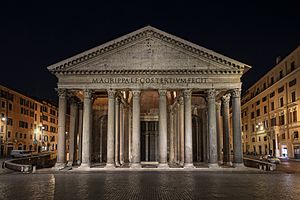
Marcus Aurelius, known as the Philosopher, was the last of the Five Good Emperors. He was a stoic philosopher and wrote the Meditations. He defeated barbarian tribes in the Marcomannic Wars as well as the Parthian Empire. His co-emperor, Lucius Verus, died in 169 AD, probably from the Antonine Plague, a pandemic that killed nearly five million people through the Empire in 165–180 AD.
From Nerva to Marcus Aurelius, the empire achieved an unprecedented status. The powerful influence of laws and manners had gradually cemented the union of the provinces. All the citizens enjoyed and abused the advantages of wealth. The image of a free constitution was preserved with decent reverence. The Roman senate appeared to possess the sovereign authority, and devolved on the emperors all the executive powers of government. Gibbon declared the rule of these "Five Good Emperors" the golden era of the Empire. During this time, Rome reached its greatest territorial extent.
Commodus, son of Marcus Aurelius, became emperor after his father's death. He is not counted as one of the Five Good Emperors, due to his direct kinship with the latter emperor; in addition, he was militarily passive. Cassius Dio identifies his reign as the beginning of Roman decadence: "(Rome has transformed) from a kingdom of gold to one of iron and rust."
Severan dynasty
Commodus was killed by a conspiracy involving Quintus Aemilius Laetus and his wife Marcia in late 192 AD. The following year is known as the Year of the Five Emperors, during which Helvius Pertinax, Didius Julianus, Pescennius Niger, Clodius Albinus and Septimius Severus held the imperial dignity. Pertinax, a member of the senate who had been one of Marcus Aurelius's right-hand men, was the choice of Laetus, and he ruled vigorously and judiciously. Laetus soon became jealous and instigated Pertinax's murder by the Praetorian Guard, who then auctioned the empire to the highest bidder, Didius Julianus, for 25,000 sesterces per man. The people of Rome were appalled and appealed to the frontier legions to save them. The legions of three frontier provinces—Britannia, Pannonia Superior, and Syria—resented being excluded from the "donative" and replied by declaring their individual generals to be emperor. Lucius Septimius Severus Geta, the Pannonian commander, bribed the opposing forces, pardoned the Praetorian Guards and installed himself as emperor. He and his successors governed with the legions' support. The changes on coinage and military expenditures were the root of the financial crisis that marked the Crisis of the Third Century.
Severus was enthroned after invading Rome and having Didius Julianus killed. Severus attempted to revive totalitarianism and, addressing the Roman people and Senate, praised the severity and cruelty of Marius and Sulla, which worried the senators. When Parthia invaded Roman territory, Severus successfully waged war against that country. Notwithstanding this military success, Severus failed in invading Hatra, a rich Arabian city. Severus killed his legate, who was gaining respect from the legions; and his soldiers fell victim to famine. After this disastrous campaign, he withdrew. Severus also intended to vanquish the whole of Britannia. To achieve this, he waged war against the Caledonians. After many casualties in the army due to the terrain and the barbarians' ambushes, Severus himself went to the field. However, he became ill and died in 211 AD, at the age of 65.
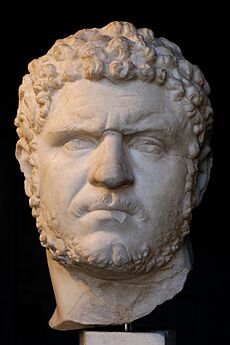
Upon the death of Severus, his sons Caracalla and Geta were made emperors. Caracalla had his brother, a youth, assassinated, and may have murdered 20,000 of Geta's followers. Like his father, Caracalla was warlike. He continued Severus' policy and gained respect from the legions. Knowing that the citizens of Alexandria disliked him and were denigrating his character, Caracalla served a banquet for its notable citizens, after which his soldiers killed all the guests. From the security of the temple of Sarapis, he then directed an indiscriminate slaughter of Alexandria's people. In 212, he issued the Edict of Caracalla, giving full Roman citizenship to all free men living in the Empire, with the exception of the dediticii, people who had become subject to Rome through surrender in war, and freed slaves.
Mary Beard points to the edict as a fundamental turning point, after which Rome was "effectively a new state masquerading under an old name".
Macrinus conspired to have Caracalla assassinated by one of his soldiers during a pilgrimage to the Temple of the Moon in Carrhae, in 217 AD. Macrinus assumed power, but soon removed himself from Rome to the east and Antioch. His brief reign ended in 218, when the youngster Bassianus, high priest of the temple of the Sun at Emesa, and supposedly illegitimate son of Caracalla, was declared Emperor by the disaffected soldiers of Macrinus. He adopted the name of Antoninus but history has named him after his Sun god Elagabalus, represented on Earth in the form of a large black stone. An incompetent ruler, Elagabalus offended all but his favourites. Elagabalus adopted his cousin Severus Alexander, as Caesar, but subsequently grew jealous and attempted to assassinate him. However, the Praetorian guard preferred Alexander and murdered Elagabalus. Severus Alexander then succeeded him. Alexander waged war against many foes, including the revitalised Persia and also the Germanic peoples, who invaded Gaul. His losses generated dissatisfaction among his soldiers, and some of them murdered him during his Germanic campaign in 235 AD.
Crisis of the Third Century
A disastrous scenario emerged after the death of Alexander Severus: the Roman state was plagued by civil wars, external invasions, political chaos, pandemics and economic depression. The old Roman values had fallen, and Mithraism and Christianity had begun to spread through the populace. Emperors were no longer men linked with nobility; they usually were born in lower-classes of distant parts of the Empire. These men rose to prominence through military ranks, and became emperors through civil wars.
There were 26 emperors in a 49-year period, a signal of political instability. Maximinus Thrax was the first ruler of that time, governing for just three years. Others ruled just for a few months, like Gordian I, Gordian II, Balbinus and Hostilian. The population and the frontiers were abandoned, since the emperors were mostly concerned with defeating rivals and establishing their power. The economy also suffered: massive military expenditures from the Severi caused a devaluation of Roman coins. Hyperinflation came at this time as well. The Plague of Cyprian broke out in 250 and killed a huge portion of the population. In 260 AD, the provinces of Syria Palaestina, Asia Minor and Egypt separated from the rest of the Roman state to form the Palmyrene Empire, ruled by Queen Zenobia and centered on Palmyra. In that same year the Gallic Empire was created by Postumus, retaining Britannia and Gaul. These countries separated from Rome after the capture of emperor Valerian by the Sassanids of Persia, the first Roman ruler to be captured by his enemies; it was a humiliating fact for the Romans. The crisis began to recede during the reigns of Claudius Gothicus (268–270), who defeated the Gothic invaders, and Aurelian (271–275), who reconquered both the Gallic and Palmyrene Empires. The crisis was overcome during the reign of Diocletian.
Empire – The Tetrarchy
Diocletian
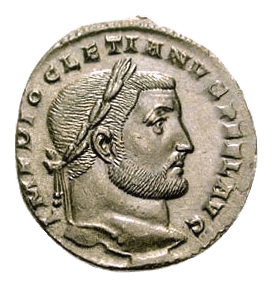
In 284 AD, Diocletian was hailed as Imperator by the eastern army. Diocletian healed the empire from the crisis, by political and economic shifts. A new form of government was established: the Tetrarchy. The Empire was divided among four emperors, two in the West and two in the East. The first tetrarchs were Diocletian (in the East), Maximian (in the West), and two junior emperors, Galerius (in the East) and Flavius Constantius (in the West). To adjust the economy, Diocletian made several tax reforms.
Diocletian expelled the Persians who plundered Syria and conquered some barbarian tribes with Maximian. He adopted many behaviours of Eastern monarchs. Anyone in the presence of the emperor had now to prostrate himself—a common act in the East, but never practised in Rome before. Diocletian did not use a disguised form of Republic, as the other emperors since Augustus had done. Between 290 and 330, half a dozen new capitals had been established by the members of the Tetrarchy, officially or not: Antioch, Nicomedia, Thessalonike, Sirmium, Milan, and Trier. Diocletian was also responsible for a significant Christian persecution. In 303 he and Galerius started the persecution and ordered the destruction of all the Christian churches and scripts and forbade Christian worship. Diocletian abdicated in 305 AD together with Maximian, thus, he was the first Roman emperor to resign. His reign ended the traditional form of imperial rule, the Principate (from princeps) and started the Tetrarchy.

Constantine and Christianity
Constantine assumed the empire as a tetrarch in 306. He conducted many wars against the other tetrarchs. Firstly he defeated Maxentius in 312. In 313, he issued the Edict of Milan, which granted liberty for Christians to profess their religion. Constantine was converted to Christianity, enforcing the Christian faith. He began the Christianization of the Empire and of Europe—a process concluded by the Catholic Church in the Middle Ages. He was defeated by the Franks and the Alamanni during 306–308. In 324 he defeated another tetrarch, Licinius, and controlled all the empire, as it was before Diocletian. To celebrate his victories and Christianity's relevance, he rebuilt Byzantium and renamed it Nova Roma ("New Rome"); but the city soon gained the informal name of Constantinople ("City of Constantine").
The reign of Julian, who under the influence of his adviser Mardonius attempted to restore Classical Roman and Hellenistic religion, only briefly interrupted the succession of Christian emperors. Constantinople served as a new capital for the Empire. In fact, Rome had lost its central importance since the Crisis of the Third Century—Mediolanum was the western capital from 286 to 330, until the reign of Honorius, when Ravenna was made capital, in the 5th century. Constantine's administrative and monetary reforms, that reunited the Empire under one emperor, and rebuilt the city of Byzantium, as Constantinopolis Nova Roma, changed the high period of the ancient world.
Fall of the Western Roman Empire
In the late 4th and 5th centuries the Western Empire entered a critical stage which terminated with the fall of the Western Roman Empire. Under the last emperors of the Constantinian dynasty and the Valentinianic dynasty, Rome lost decisive battles against the Sasanian Empire and Germanic barbarians: in 363, emperor Julian the Apostate was killed in the Battle of Samarra, against the Persians and the Battle of Adrianople cost the life of emperor Valens (364–378); the victorious Goths were never expelled from the Empire nor assimilated. The next emperor, Theodosius I (379–395), gave even more force to the Christian faith, and after his death, the Empire was divided into the Eastern Roman Empire, ruled by Arcadius and the Western Roman Empire, commanded by Honorius, both of which were Theodosius' sons.
The situation became more critical in 408, after the death of Stilicho, a general who tried to reunite the Empire and repel barbarian invasion in the early years of the 5th century. The professional field army collapsed. In 410, the Theodosian dynasty saw the Visigoths sack Rome. During the 5th century, the Western Empire experienced a significant reduction of its territory. The Vandals conquered North Africa, the Visigoths claimed the southern part of Gaul, Gallaecia was taken by the Suebi, Britannia was abandoned by the central government, and the Empire suffered further from the invasions of Attila, chief of the Huns. General Orestes refused to meet the demands of the barbarian "allies" who now formed the army, and tried to expel them from Italy. Unhappy with this, their chieftain Odoacer defeated and killed Orestes, invaded Ravenna and dethroned Romulus Augustus, son of Orestes. This event of 476, usually marks the end of Classical antiquity and beginning of the Middle Ages. The Roman noble and former emperor Julius Nepos continued to rule as emperor from Dalmatia even after the deposition of Romulus Augustus until his death in 480. Some historians consider him to be the last emperor of the Western Empire instead of Romulus Augustus.
After 1200 years of independence and nearly 700 years as a great power, the rule of Rome in the West ended. Various reasons for Rome's fall have been proposed ever since, including loss of Republicanism, moral decay, military tyranny, class war, slavery, economic stagnation, environmental change, disease, the decline of the Roman race, as well as the inevitable ebb and flow that all civilisations experience. The Eastern Empire survived for almost 1000 years after the fall of its Western counterpart and became the most stable Christian realm during the Middle Ages. During the 6th century, Justinian reconquered the Italian peninsula from the Ostrogoths, North Africa from the Vandals, and southern Hispania from the Visigoths. But within a few years of Justinian's death, Eastern Roman (Byzantine) possessions in Italy were greatly reduced by the Lombards who settled in the peninsula. In the east, partially due to the weakening effect of the Plague of Justinian as well as a series of mutually destructive wars against the Persian Sassanian Empire, the Byzantine Romans were threatened by the rise of Islam. Its followers rapidly brought about the conquest of the Levant, the conquest of Armenia and the conquest of Egypt during the Arab–Byzantine wars, and soon presented a direct threat to Constantinople. In the following century, the Arabs captured southern Italy and Sicily. In the west, Slavic populations penetrated deep into the Balkans.
The Byzantine Romans, however, managed to stop further Islamic expansion into their lands during the 8th century and, beginning in the 9th century, reclaimed parts of the conquered lands. In 1000 AD, the Eastern Empire was at its height: Basil II reconquered Bulgaria and Armenia, and culture and trade flourished. However, soon after, this expansion was abruptly stopped in 1071 with the Byzantine defeat in the Battle of Manzikert. The aftermath of this battle sent the empire into a protracted period of decline. Two decades of internal strife and Turkic invasions ultimately led Emperor Alexios I Komnenos to send a call for help to the Western European kingdoms in 1095. The West responded with the Crusades, eventually resulting in the Sack of Constantinople by participants of the Fourth Crusade. The conquest of Constantinople in 1204 fragmented what remained of the Empire into successor states; the ultimate victor was the Empire of Nicaea. After the recapture of Constantinople by Imperial forces, the Empire was little more than a Greek state confined to the Aegean coast. The Eastern Roman (Byzantine) Empire collapsed when Mehmed the Conqueror conquered Constantinople on 29 May 1453.
Society

The imperial city of Rome was the largest urban center in the empire, with a population variously estimated from 450,000 to close to one million. Around 20 per cent of the population under jurisdiction of ancient Rome (25–40%, depending on the standards used, in Roman Italy) lived in innumerable urban centers, with population of 10,000 and more and several military settlements, a very high rate of urbanisation by pre-industrial standards. Most of those centers had a forum, temples, and other buildings similar to Rome's. The average life expectancy in the Middle Empire was about 26–28 years.
Law
The roots of the legal principles and practices of the ancient Romans may be traced to the Law of the Twelve Tables promulgated in 449 BC and to the codification of law issued by order of Emperor Justinian I around 530 AD (see Corpus Juris Civilis). Roman law as preserved in Justinian's codes continued into the Byzantine Roman Empire, and formed the basis of similar codifications in continental Western Europe. Roman law continued, in a broader sense, to be applied throughout most of Europe until the end of the 17th century.
The major divisions of the law of ancient Rome, as contained within the Justinian and Theodosian law codes, consisted of Jus civile, Jus gentium, and Jus naturale. The Jus civile ("Citizen Law") was the body of common laws that applied to Roman citizens. The praetores urbani (sg. Praetor Urbanus) were the people who had jurisdiction over cases involving citizens. The Jus gentium ("Law of nations") was the body of common laws that applied to foreigners, and their dealings with Roman citizens. The praetores peregrini (sg. Praetor Peregrinus) were the people who had jurisdiction over cases involving citizens and foreigners. Jus naturale encompassed natural law, the body of laws that were considered common to all beings.
Class structure
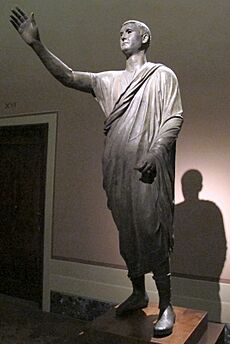
Roman society is largely viewed as hierarchical, with slaves (servi) at the bottom, freedmen (liberti) above them, and free-born citizens (cives) at the top. Free citizens were subdivided by class. The broadest, and earliest, division was between the patricians, who could trace their ancestry to one of the 100 patriarchs at the founding of the city, and the plebeians, who could not. This became less important in the later Republic, as some plebeian families became wealthy and entered politics, and some patrician families fell economically. Anyone, patrician or plebeian, who could count a consul as his ancestor was a noble (nobilis); a man who was the first of his family to hold the consulship, such as Marius or Cicero, was known as a novus homo ("new man") and ennobled his descendants. Patrician ancestry, however, still conferred considerable prestige, and many religious offices remained restricted to patricians.
A class division originally based on military service became more important. Membership of these classes was determined periodically by the censors, according to property. The wealthiest were the Senatorial class, who dominated politics and command of the army. Next came the equestrians (equites, sometimes translated "knights"), originally those who could afford a warhorse, and who formed a powerful mercantile class. Several further classes, originally based on the military equipment their members could afford, followed, with the proletarii, citizens who had no property other than their children, at the bottom. Before the reforms of Marius they were ineligible for military service and are often described as being just above freed slaves in wealth and prestige.
Voting power in the Republic depended on class. Citizens were enrolled in voting "tribes", but the tribes of the richer classes had fewer members than the poorer ones, all the proletarii being enrolled in a single tribe. Voting was done in class order, from top down, and stopped as soon as most of the tribes had been reached, so the poorer classes were often unable to cast their votes.
Women in ancient Rome shared some basic rights with their male counterparts, but were not fully regarded as citizens and were thus not allowed to vote or take part in politics. At the same time the limited rights of women were gradually expanded (due to emancipation) and women reached freedom from pater familias, gained property rights and even had more juridical rights than their husbands, but still no voting rights, and were absent from politics.
Allied foreign cities were often given the Latin Rights, an intermediary level between full citizens and foreigners (peregrini), which gave their citizens rights under Roman law and allowed their leading magistrates to become full Roman citizens. While there were varying degrees of Latin rights, the main division was between those cum suffragio ("with vote"; enrolled in a Roman tribe and able to take part in the comitia tributa) and sine suffragio ("without vote"; could not take part in Roman politics). Most of Rome's Italian allies were given full citizenship after the Social War of 91–88 BC, and full Roman citizenship was extended to all free-born men in the Empire by Caracalla in 212, with the exception of the dediticii, people who had become subject to Rome through surrender in war, and freed slaves.
Education
In the early Republic, there were no public schools, so boys were taught to read and write by their parents, or by educated slaves, called paedagogi, usually of Greek origin. The primary aim of education during this period was to train young men in agriculture, warfare, Roman traditions, and public affairs. Young boys learned much about civic life by accompanying their fathers to religious and political functions, including the Senate for the sons of nobles. The sons of nobles were apprenticed to a prominent political figure at the age of 16, and campaigned with the army from the age of 17. Educational practices were modified after the conquest of the Hellenistic kingdoms in the 3rd century BC and the resulting Greek influence, although Roman educational practices were still much different from Greek ones. If their parents could afford it, boys and some girls at the age of 7 were sent to a private school outside the home called a ludus, where a teacher (called a litterator or a magister ludi, and often of Greek origin) taught them basic reading, writing, arithmetic, and sometimes Greek, until the age of 11.
Beginning at age 12, students went to secondary schools, where the teacher (now called a grammaticus) taught them about Greek and Roman literature. At the age of 16, some students went on to rhetoric school (where the teacher, usually Greek, was called a rhetor). Education at this level prepared students for legal careers, and required that the students memorise the laws of Rome.
Government
Initially, Rome was ruled by kings, who were elected from each of Rome's major tribes in turn. The exact nature of the king's power is uncertain. He may have held near-absolute power, or may have merely been the chief executive of the Senate and the people. In military matters, the king's authority (Imperium) was likely absolute. He was also the head of the state religion. In addition to the authority of the King, there were three administrative assemblies: the Senate, which acted as an advisory body for the King; the Comitia Curiata, which could endorse and ratify laws suggested by the King; and the Comitia Calata, which was an assembly of the priestly college that could assemble the people to bear witness to certain acts, hear proclamations, and declare the feast and holiday schedule for the next month.

The class struggles of the Roman Republic resulted in an unusual mixture of democracy and oligarchy. The word republic comes from the Latin res publica, which literally translates to "public business". Roman laws traditionally could only be passed by a vote of the Popular assembly (Comitia Tributa). Likewise, candidates for public positions had to run for election by the people. However, the Roman Senate represented an oligarchic institution, which acted as an advisory body.
In the Republic, the Senate held actual authority (auctoritas), but no real legislative power; it was technically only an advisory council. However, as the Senators were individually very influential, it was difficult to accomplish anything against the collective will of the Senate. New senators were chosen from among the most accomplished patricians by censors (Censura), who could also remove a senator from his office if he was found "morally corrupt"; a charge that could include bribery or, as under Cato the Elder, embracing one's wife in public. Later, under the reforms of the dictator Sulla, quaestors were made automatic members of the Senate, though most of his reforms did not survive.
The Republic had no fixed bureaucracy, and collected taxes through the practice of tax farming. Government positions such as quaestor, aedile, or praefect were funded by the office-holder. To prevent any citizen from gaining too much power, new magistrates were elected annually and had to share power with a colleague. For example, under normal conditions, the highest authority was held by two consuls. In an emergency, a temporary dictator could be appointed. Throughout the Republic, the administrative system was revised several times to comply with new demands. In the end, it proved inefficient for controlling the ever-expanding dominion of Rome, contributing to the establishment of the Roman Empire.
In the early Empire, the pretense of a republican form of government was maintained. The Roman Emperor was portrayed as only a princeps, or "first citizen", and the Senate gained legislative power and all legal authority previously held by the popular assemblies. However, the rule of the Emperors became increasingly autocratic, and the Senate was reduced to an advisory body appointed by the Emperor. The Empire did not inherit a set bureaucracy from the Republic, since the Republic did not have any permanent governmental structures apart from the Senate. The Emperor appointed assistants and advisers, but the state lacked many institutions, such as a centrally planned budget. Some historians have cited this as a significant reason for the decline of the Roman Empire.
Military
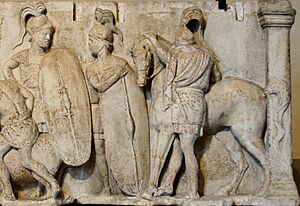
The early Roman army (c. 500 BC) was, like those of other contemporary city-states influenced by Greek civilisation, a citizen militia that practised hoplite tactics. It was small and organised in five classes (in parallel to the comitia centuriata, the body of citizens organised politically), with three providing hoplites and two providing light infantry. The early Roman army was tactically limited and its stance during this period was essentially defensive.
By the 3rd century BC, the Romans abandoned the hoplite formation in favour of a more flexible system in which smaller groups of 120 (or sometimes 60) men called maniples could manoeuvre more independently on the battlefield. Thirty maniples arranged in three lines with supporting troops constituted a legion, totalling between 4,000 and 5,000 men. The early Republican legion consisted of five sections: the three lines of manipular heavy infantry (hastati, principes and triarii), a force of light infantry (velites), and the cavalry (equites). With the new organisation came a new orientation toward the offensive and a much more aggressive posture toward adjoining city-states. At nominal full strength, an early Republican legion included 3,600 to 4,800 heavy infantry, several hundred light infantry, and several hundred cavalrymen.
Until the late Republican period, the typical legionary was a property-owning citizen farmer from a rural area (an adsiduus) who served for particular (often annual) campaigns, and who supplied his own equipment. After 200 BC, economic conditions in rural areas deteriorated as manpower needs increased, so that the property qualifications for compulsory service were gradually reduced. Beginning in the 3rd century BC, legionaries were paid a stipend (stipendium). By the time of Augustus, the ideal of the citizen-soldier had been abandoned and the legions had become fully professional. At the end of the Civil War, Augustus reorganised Roman military forces, discharging soldiers and disbanding legions. He retained 28 legions, distributed through the provinces of the Empire.
During the Principate, the tactical organisation of the Army continued to evolve. The auxilia remained independent cohorts, and legionary troops often operated as groups of cohorts rather than as full legions. A new and versatile type of unit, the cohortes equitatae, combined cavalry and legionaries in a single formation. They could be stationed at garrisons or outposts and could fight on their own as balanced small forces or combine with similar units as a larger, legion-sized force. This increase in organizational flexibility helped ensure the long-term success of Roman military forces. The Emperor Gallienus (253–268 AD) began a reorganisation that created the last military structure of the late Empire. Withdrawing some legionaries from the fixed bases on the border, Gallienus created mobile forces (the comitatenses or field armies) and stationed them behind and at some distance from the borders as a strategic reserve. The border troops (limitanei) stationed at fixed bases continued to be the first line of defence. The basic units of the field army were regimental; legiones or auxilia for infantry and vexillationes for cavalry. Nominal strengths may have been 1,200 men for infantry regiments and 600 for cavalry, but actual troop levels could have been much lower—800 infantry and 400 cavalry. Many infantry and cavalry regiments operated in pairs under the command of a comes. Field armies included regiments recruited from allied tribes and known as foederati. By 400 AD, foederati regiments had become permanently established units of the Roman army, paid and equipped by the Empire, led by a Roman tribune and used just as Roman units were used. The Empire also used groups of barbarians to fight along with the legions as allies without integration into the field armies, under overall command of a Roman general, but led by their own officers.
Military leadership evolved over the course of the history of Rome. Under the monarchy, the hoplite armies were led by the kings. During the early and middle Roman Republic, military forces were under the command of one of the two elected consuls for the year. During the later Republic, members of the Roman Senatorial elite, as part of the normal sequence of elected public offices known as the cursus honorum, would have served first as quaestor (often posted as deputies to field commanders), then as praetor. Following the end of a term as praetor or consul, a Senator might be appointed by the Senate as a propraetor or proconsul (depending on the highest office held before) to govern a foreign province. Under Augustus, whose most important political priority was to place the military under a permanent and unitary command, the Emperor was the legal commander of each legion but exercised that command through a legatus (legate) he appointed from the Senatorial elite. In a province with a single legion, the legate commanded the legion (legatus legionis) and served as provincial governor, while in a province with more than one legion, each legion was commanded by a legate and the legates were commanded by the provincial governor (also a legate but of higher rank).
During the later stages of the Imperial period (beginning perhaps with Diocletian), the Augustan model was abandoned. Provincial governors were stripped of military authority, and command of the armies in a group of provinces was given to generals (duces) appointed by the Emperor. These were no longer members of the Roman elite but men who came up through the ranks and had seen much practical soldiering. With increasing frequency, these men attempted (sometimes successfully) to usurp the positions of the Emperors. Decreased resources, increasing political chaos and civil war eventually left the Western Empire vulnerable to attack and takeover by neighbouring barbarian peoples.
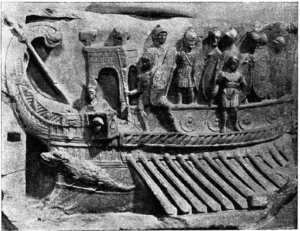
Less is known about the Roman navy than the Roman army. Prior to the middle of the 3rd century BC, officials known as duumviri navales commanded a fleet of twenty ships used mainly to control piracy. This fleet was given up in 278 AD and replaced by allied forces. The First Punic War required that Rome build large fleets, and it did so largely with the assistance of and financing from allies. This reliance on allies continued to the end of the Roman Republic. The quinquereme was the main warship on both sides of the Punic Wars and remained the mainstay of Roman naval forces until replaced by the time of Caesar Augustus by lighter and more manoeuvrable vessels.
As compared with a trireme, the quinquereme permitted the use of a mix of experienced and inexperienced crewmen (an advantage for a primarily land-based power), and its lesser manoeuvrability permitted the Romans to adopt and perfect boarding tactics using a troop of about 40 marines in lieu of the ram. Ships were commanded by a navarch, a rank equal to a centurion, who was usually not a citizen. Potter suggests that because the fleet was dominated by non-Romans, the navy was considered non-Roman and allowed to atrophy in times of peace.
Information suggests that by the time of the late Empire (350 AD), the Roman navy comprised several fleets including warships and merchant vessels for transportation and supply. Warships were oared sailing galleys with three to five banks of oarsmen. Fleet bases included such ports as Ravenna, Arles, Aquilea, Misenum and the mouth of the Somme River in the West and Alexandria and Rhodes in the East. Flotillas of small river craft (classes) were part of the limitanei (border troops) during this period, based at fortified river harbours along the Rhine and the Danube. That prominent generals commanded both armies and fleets suggests that naval forces were treated as auxiliaries to the army and not as an independent service. The details of command structure and fleet strengths during this period are not well known, although fleets were commanded by prefects.
Economy
Ancient Rome commanded a vast area of land, with tremendous natural and human resources. As such, Rome's economy remained focused on farming and trade. Agricultural free trade changed the Italian landscape, and by the 1st century BC, vast grape and olive estates had supplanted the yeoman farmers, who were unable to match the imported grain price. The annexation of Egypt, Sicily and Tunisia in North Africa provided a continuous supply of grains. In turn, olive oil and wine were Italy's main exports. Two-tier crop rotation was practised, but farm productivity was low, around 1 ton per hectare.
Industrial and manufacturing activities were small. The largest such activities were the mining and quarrying of stones, which provided basic construction materials for the buildings of that period. In manufacturing, production was on a relatively small scale, and generally consisted of workshops and small factories that employed at most dozens of workers. However, some brick factories employed hundreds of workers.
The economy of the early Republic was largely based on smallholding and paid labour. However, foreign wars and conquests made slaves increasingly cheap and plentiful, and by the late Republic, the economy was largely dependent on slave labour for both skilled and unskilled work. Slaves are estimated to have constituted around 20% of the Roman Empire's population at this time and 40% in the city of Rome. Only in the Roman Empire, when the conquests stopped and the prices of slaves increased, did hired labour become more economical than slave ownership.
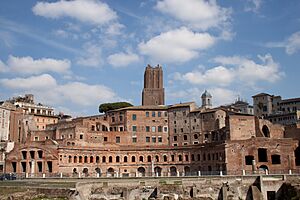
Although barter was used in ancient Rome, and often used in tax collection, Rome had a very developed coinage system, with brass, bronze, and precious metal coins in circulation throughout the Empire and beyond—some have even been discovered in India. Before the 3rd century BC, copper was traded by weight, measured in unmarked lumps, across central Italy. The original copper coins (as) had a face value of one Roman pound of copper, but weighed less. Thus, Roman money's utility as a unit of exchange consistently exceeded its intrinsic value as metal. After Nero began debasing the silver denarius, its legal value was an estimated one-third greater than its intrinsic value.
Horses were expensive and other pack animals were slower. Mass trade on the Roman roads connected military posts, where Roman markets were centered. These roads were designed for wheels. As a result, there was transport of commodities between Roman regions, but increased with the rise of Roman maritime trade in the 2nd century BC. During that period, a trading vessel took less than a month to complete a trip from Gades to Alexandria via Ostia, spanning the entire length of the Mediterranean. Transport by sea was around 60 times cheaper than by land, so the volume for such trips was much larger.
Some economists consider the Roman Empire a market economy, similar in its degree of capitalistic practices to 17th century Netherlands and 18th century England.
Culture
Roman culture spread to Western Europe and the area around the Mediterranean Sea. Its history still has a big influence on the world today. For example, Roman ideas about laws, government, art, literature, and language are important to European culture. The Roman language, Latin, slowly evolved, becoming modern French, Spanish, Italian, Romanian, and many other languages. Latin also indirectly influenced many other languages such as English.
Religion
Beginning with Emperor Nero in the first century AD, the Roman government did not like Christianity. At certain points in history, people could be put to death because they were Christians. Under Emperor Diocletian, the persecution of Christians became the strongest. However, Christianity became an officially supported religion in the Roman Empire under Constantine I, who was the next Emperor. With the signing of the Edict of Milan in 313, it quickly became the biggest religion. Then in 391 AD by an edict of Emperor Theodosius I made Christianity Rome's official religion.
Cuisine
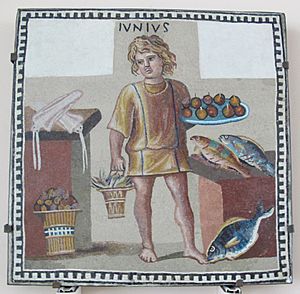
Ancient Roman cuisine changed over the long duration of this ancient civilisation. Dietary habits were affected by the influence of Greek culture, the political changes from Kingdom to Republic to Empire, and the Empire's enormous expansion, which exposed Romans to many new, provincial culinary habits and cooking techniques. In the beginning the differences between social classes were relatively small, but disparities evolved with the Empire's growth. Men and women drank wine with their meals.
The ancient Roman diet included many items that are staples of modern Italian cooking. Pliny the Elder discussed more than 30 varieties of olive, 40 kinds of pear, figs (native and imported from Africa and the eastern provinces), and a wide variety of vegetables, including carrots (of different colours, but not orange) as well as celery, garlic, some flower bulbs, cabbage and other brassicas (such as kale and broccoli), lettuce, endive, onion, leek, asparagus, radishes, turnips, parsnips, beets, green peas, chard, cardoons, olives, and cucumber.
However, some foods now considered characteristic of modern Italian cuisine were not used. In particular, spinach and eggplant (aubergine) were introduced later from the Arab world, and tomatoes, potatoes, capsicum peppers, and maize (the modern source of polenta) only appeared in Europe following the discovery of the New World and the Columbian Exchange. The Romans knew of rice, but it was very rarely available to them. There were also few citrus fruits.
Butcher's meat such as beef was an uncommon luxury. The most popular meat was pork, especially sausages. Fish was more common than meat, with a sophisticated aquaculture and large-scale industries devoted to oyster farming. The Romans also engaged in snail farming and oak grub farming. Some fish were greatly esteemed and fetched high prices, such as mullet raised in the fishery at Cosa, and "elaborate means were invented to assure its freshness".
Traditionally, a breakfast called ientaculum was served at dawn. At mid-day to early afternoon, Romans ate cena, the main meal of the day, and at nightfall a light supper called vesperna. With the increased importation of foreign foods, the cena grew larger in size and included a wider range of foods. Thus, it gradually shifted to the evening, while the vesperna was abandoned completely over the course of the years. The mid-day meal prandium became a light meal to hold one over until cena.
Fashion
The toga, a common garment during the era of Julius Caesar, was gradually abandoned by all social classes of the Empire. At the early 4th century, the toga had become just a garment worn by senators in Senate and ceremonial events. At the 4th century, the toga was replaced by the paenula (a garment similar to a poncho) as the everyday garment of the Romans, from the lower classes to the upper classes. Another garment that was popular among the Romans in the later years of the Western Roman Empire was the pallium, which was mostly worn by philosophers and scholars in general. Due to external influences, mainly from the Germanic peoples, the Romans adopted tunics very similar to those used by the Germanic peoples with whom they interacted in the final years of the Western Empire, also adopted trousers and hats like the pileus pannonicus. At the Late Empire the paludamentum (a type of military clothing) was used only by the Emperor of Rome (since the reign of Augustus, the first emperor) while the dalmatic (also used by the Christian clergy) began to spread throughout the empire.
Technology
Ancient Rome boasted impressive technological feats, using many advancements that were lost in the Middle Ages and not rivalled again until the 19th and 20th centuries. An example of this is insulated glazing, which was not invented again until the 1930s. Many practical Roman innovations were adopted from earlier Greek designs. Advancements were often divided and based on craft. Artisans guarded technologies as trade secrets.
Roman civil engineering and military engineering constituted a large part of Rome's technological superiority and legacy, and contributed to the construction of hundreds of roads, bridges, aqueducts, public baths, theatres and arenas. Many monuments, such as the Colosseum, Pont du Gard, and Pantheon, remain as testaments to Roman engineering and culture.
The Romans were renowned for their architecture, which is grouped with Greek traditions into "Classical architecture". Although there were many differences from Greek architecture, Rome borrowed heavily from Greece in adhering to strict, formulaic building designs and proportions. Aside from two new orders of columns, composite and Tuscan, and from the dome, which was derived from the Etruscan arch, Rome had relatively few architectural innovations until the end of the Republic.
In the 1st century BC, Romans started to use Roman concrete widely. Concrete was invented in the late 3rd century BC. It was a powerful cement derived from pozzolana, and soon supplanted marble as the chief Roman building material and allowed many daring architectural forms. Also in the 1st century BC, Vitruvius wrote De architectura, possibly the first complete treatise on architecture in history. In the late 1st century BC, Rome also began to use glassblowing soon after its invention in Syria about 50 BC. Mosaics took the Empire by storm after samples were retrieved during Lucius Cornelius Sulla's campaigns in Greece.
The Romans also largely built using timber, causing a rapid decline of the woodlands surrounding Rome and in much of the Apennine Mountains due to the demand for wood for construction, shipbuilding and fire. The first evidence of long-distance wood trading come from the discovery of wood planks, felled between AD 40 and 60, coming from the Jura mountains in northeastern France and ending up more than 1,055 miles (1,700 km) away, in the foundations of a lavish portico that was part of a vast wealthy patrician villa, in Central Rome. It is suggested that timber, around 4 metres (13 ft) long, came up to Rome via the Tiber River on ships travelling across the Mediterranean Sea from the confluence of the Saône and Rhône rivers in what is now the city of Lyon in present-day France.
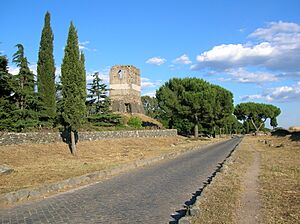
With solid foundations and good drainage, Roman roads were known for their durability and many segments of the Roman road system were still in use a thousand years after the fall of Rome. The construction of a vast and efficient travel network throughout the Empire dramatically increased Rome's power and influence. They allowed Roman legions to be deployed rapidly, with predictable marching times between key points of the empire, no matter the season. These highways also had enormous economic significance, solidifying Rome's role as a trading crossroads—the origin of the saying "all roads lead to Rome". The Roman government maintained a system of way stations, known as the cursus publicus, and established a system of horse relays allowing a dispatch to travel up to 80 km (50 mi) a day.
The Romans constructed numerous aqueducts to supply water to cities and industrial sites and to aid in their agriculture. By the third century, the city of Rome was supplied by 11 aqueducts with a combined length of 450 km (280 mi). The Romans also made major advancements in sanitation. Romans were particularly famous for their public baths, called thermae, which were used for both hygienic and social purposes. Many Roman houses had flush toilets and indoor plumbing, and a complex sewer system, the Cloaca Maxima, was used to drain the local marshes and carry waste into the Tiber. Some historians have speculated that lead pipes in the sewer and plumbing systems led to widespread lead poisoning, which contributed to fall of Rome; however, lead content would have been minimised.
Archaeology
Remains of Roman work and architecture have been found in the furthest corners of the late Empire.
Related pages
- Roman Kingdom
- Roman Republic
- Roman Empire
- Western Roman Empire
- Byzantine Empire
- Culture of ancient Rome
- Roman food
Images for kids
-
According to legend, Rome was founded in 753 BC by Romulus and Remus, who were raised by a she-wolf
-
Frescoes from the Villa of the Mysteries in Pompeii, Italy, Roman artwork dated to the mid-1st century BC
-
Woman playing a kithara, from the Villa Boscoreale, 40–30 BC
-
A vomitorium at the Roman amphitheatre in Trier
See also
 In Spanish: Antigua Roma para niños
In Spanish: Antigua Roma para niños


